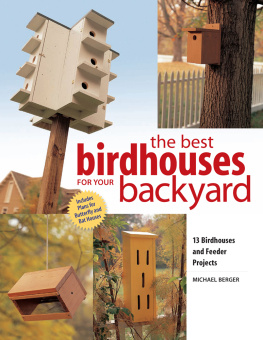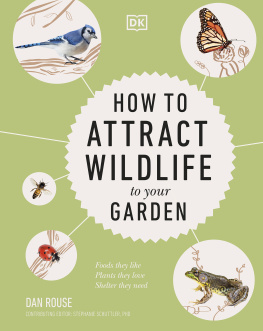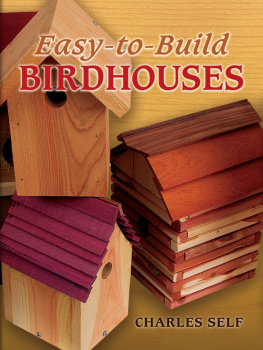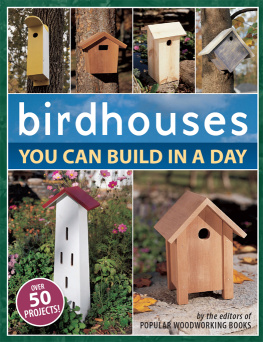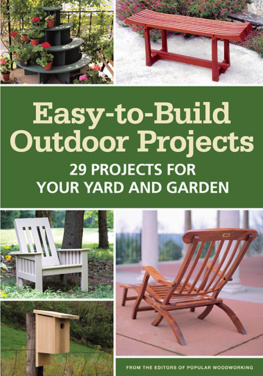the best
birdhouses
FOR YOUR backyard
MICHAEL BERGER

The Best Birdhouses for Your Backyard. Copyright 2001 by Michael Berger. Manufactured in China. All rights reserved. No part of this book may be reproduced in any form or by any electronic or mechanical means including information storage and retrieval systems without permission in writing from the publisher, except by a reviewer, who may quote brief passages in a review. Published by Popular Woodworking Books, an imprint of F&W Publications, Inc., 1507 Dana Avenue, Cincinnati, Ohio, 45207. First edition.
Visit our Web site at www.popularwoodworking.com for information and resources for woodworkers.
Other fine Popular Woodworking Books are available from your local bookstore or direct from the publisher.
05 04 03 02 01 5 4 3 2 1
Library of Congress Cataloging-in-Publication Data
Berger, Michael,
The best birdhouses for your backyard / by Michael Berger
p. cm.
Includes index.
ISBN 1-55870-583-X (alk. paper)
eISBN-13: 978-1-4403-1637-1
1. Birdhouses Design and construction. I. Title.
QL676.5 .B39 2001
728'.927 dc21 2001018510
Edited by Jennifer Churchill
Designed by Brian Roeth
Interior art production by Kathy Gardner
Illustrations by Len Churchill
Cover and finished projects photographed by Al Parrish
Step photographs by Jennifer Churchill and Jim Stack
Production coordinated by Sara Dumford
METRIC CONVERSION CHART
to convert | to | multiply by |
Inches | Centimeters | 2.54 |
Centimeters | Inches | 0.4 |
Feet | Centimeters | 30.5 |
Centimeters | Feet | 0.03 |
Yards | Meters | 0.9 |
Meters | Yards | 1.1 |
Sq. Inches | Sq. Centimeters | 6.45 |
Sq. Centimeters | Sq. Inches | 0.16 |
Sq. Feet | Sq. Meters | 0.09 |
Sq. Meters | Sq. Feet | 10.8 |
Sq. Yards | Sq. Meters | 0.8 |
Sq. Meters | Sq. Yards | 1.2 |
Pounds | Kilograms | 0.45 |
Kilograms | Pounds | 2.2 |
Ounces | Grams | 28.4 |
Grams | Ounces | 0.04 |

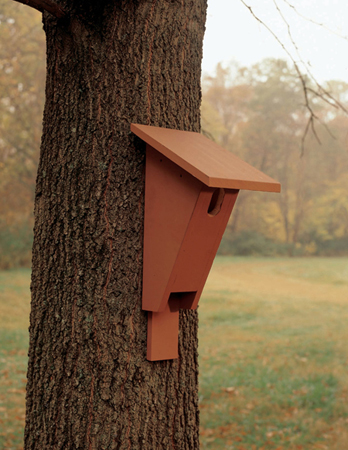
READ THIS IMPORTANT SAFETY NOTICE
To prevent accidents, keep safety in mind while you work. Use the safety guards installed on power equipment; they are for your protection. When working on power equipment, keep fingers away from saw blades, wear safety goggles to prevent injuries from flying wood chips and saw-dust, wear headphones to protect your hearing, and consider installing a dust vacuum to reduce the amount of airborne sawdust in your wood-shop. Don't wear loose clothing, such as neckties or shirts with loose sleeves, or jewelry, such as rings, necklaces or bracelets, when working on power equipment. Tie back long hair to prevent it from getting caught in your equipment. People who are sensitive to certain chemicals should check the chemical content of any product before using it. The author and editors who compiled this book have tried to make the contents as accurate and correct as possible. Plans, illustrations, photographs and text have been carefully checked. All instructions, plans and projects should be carefully read, studied and understood before beginning construction. Due to the variability of local conditions, construction materials, skill levels, etc., neither the author nor Popular Woodworking Books assumes any responsibility for any accidents, injuries, damages or other losses incurred resulting from the material presented in this book.
dedication
To my mother, Marcella, who taught me what a rain crow was; to my father, Fred, for allowing me to lose more tools as a child than can be counted; and to my wife, Mary, for putting up with eccentricities and sawdust well past the point of reason, this book is lovingly dedicated.
about the author

Birds are nothing new to Michael Berger. Introduced as a small child to bird watching and bird feeding by his father and two great aunts, he has been actively finding ways to promote those activities in others ever since.
Over the years, he has received numerous commendations for his conservation efforts. As an Eagle Scout and assistant cubmaster for the Cub Scouts of America, Michael works at instilling his love for the outdoors in both children and adults alike. He is an avid caver and scuba diver, and is a member of the National Speleological Society.
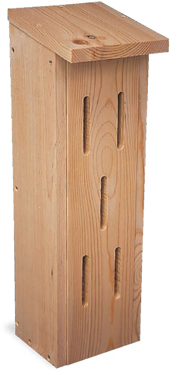
acknowledgements
There are many people who deserve special mention with regard to the creation of this book. First, to Jim Stack and David Lewis for accepting my proposal, I owe my thanks. And to all the dedicated staff at Popular Woodworking Books: Jennifer Churchill, my talented editor; Brian Roeth, the designer, for creating such a wonderful package for this information; and to all the unsung heroes of the publishing world the copyeditors, proofreaders, layout artists, indexers and production coordinators, many thanks.
There have been other special individuals throughout the years who have helped instill in me the knowledge and love of the outdoors. Stacy Doose, scout leader and caver extraordinaire, who got me hooked on caving and bats; George McElroy, who gave me my first birdhouse; and countless others with whom I have had the pleasure of hiking and birding over the years. Thank you for the wisdom and love of all things outdoors that you helped pass along.
introduction

O ne of my earliest memories is of bird-houses. I grew up out in the country, and spent the better part of my early years wandering around my one-acre yard, a yard with a fence that was made up of old-fashioned wooden posts and cross braces. About four feet up from the ground, birdhouses were attached to intermittent posts. My father had built them to attract bluebirds, wrens and other songbirds. And as I was a child, the bird-houses were one of the few things in our yard at my eye level. I would go from house to house, peeking in the holes to see who was home and if there were any eggs. More than once I was rewarded with a flap of feathers in my face as the occupant beat wings for higher ground where it would be safe from the prying eyes of miniature humans.

